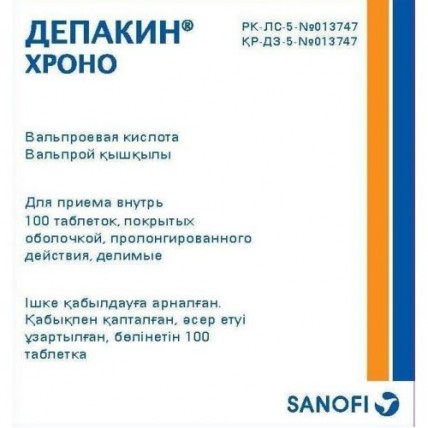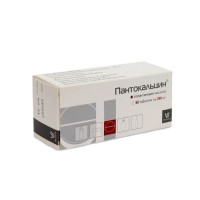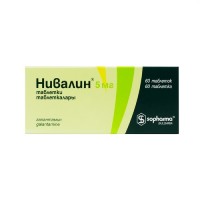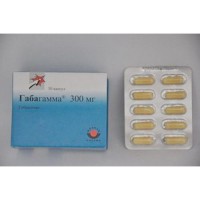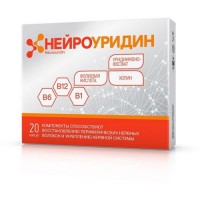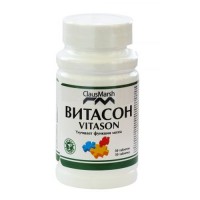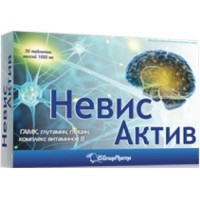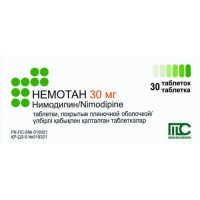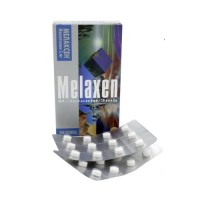Depakinum chrono 300mg tablets coated 100s
- $54.40
The instruction for medical use of medicine
Hrono Depakinum
A trade name
Hrono Depakinum
The international unlicensed
name Valproic acid
A dosage form
of the Tablet, coated, the prolonged action, dividends, 300 mg
Structure
One tablet contains
active agents: sodium Valproatum of 199.8 mg
valproic acid of 87.0 mg, (that corresponds to 300
mg of sodium of Valproatum
excipients: gipromelloza 4000, ethyl cellulose, saccharin
of sodium, silicon dioxide colloidal.
structure of a cover: gipromelloza, macrogoal 6000, talc, titan dioxide (E171), polyacrylate dispersion of 30%.
The description
Oblong tablets, film coated almost white color, from dividing risky.
Pharmacotherapeutic group
Antiepileptic drugs. Fatty acids derivatives.
Valproic acid. The ATX N03AG01 code
The pharmacological
Pharmacokinetics Bioavailability properties of Valproatum in blood at oral administration it is close to 100%.
Drug is distributed by the most part in a system blood stream and in
extracellular liquid. Valproatum gets into cerebrospinal liquid and tissues of a brain. Elimination half-life makes 15 - 17 h. The minimum concentration in blood serum of 4050 mg/l fluctuating within 40100 mg/l is necessary for therapeutic effect. If higher plasma concentration is required, it is necessary to weigh advantage and risk of development of undesirable effects, especially, dose-dependent. Despite this, at the concentration remaining at the levels over 150 mg/l, the dose needs to be lowered. Steady concentration in blood plasma is reached in 3-4 days. Linking with blood proteins is dose-dependent and saturable. Valproatum is exposed to metabolism glyukuron-conjugation and beta oxidation, then is removed, mainly with urine. Can be exposed to dialysis, however, the hemodialysis is effective only concerning free fraction of Valproatum in blood (about 10%). Valproatum does not induce the enzymes involved in the metabolic system of P450 cytochrome. Unlike the majority of other antiepileptic means it does not accelerate either own degradation, or that of other substances, such as estrogen-progestageny and oral anticoagulants. When comparing with a gastrorezistentny dosage form of Valproatum, disappearance of the period of delay at absorption, the prolonged absorption, identical bioavailability is characteristic of a dosage form of the prolonged release at the same doses, lower the general maximum concentration and plasma concentration of free substance (Cmax, about, 25% lower with rather stable plateau in 414 hours after introduction), this effect of smoothing of a maximum provides more constant and more evenly distributed concentration of valproic acid throughout the 24-hour period: after introduction of the same dose twice a day amplitude of fluctuations of plasma concentration decreases half, the linear dependence between a dose and plasma concentration (the general and free substance) is more significant.
The pharmacodynamics
Hrono Depakinum affects mainly
the central nervous system. Anticonvulsant effect of Hrono Depakinum is shown
concerning various types of convulsive attacks of epilepsy at the person.
Hrono Depakinum possesses two types of anticonvulsant action:
the first type is the direct pharmacological effect connected with concentration of Hrono Depakinum in plasma and tissues
of a brain, the second type of action indirect and is probably connected with Valproatum metabolites which are in brain tissues or with changes of neurotransmitters or direct impact on a membrane. The most widely recognized hypothesis is connected with the level of piperidic acid (GAMK) which increases after Hrono Depakinum use.
Hrono Depakin reduces duration of an intermediate phase of a dream with simultaneous increase in its slow and wave component.
Indications
- treatment of epilepsy at adults and children as monotherapy or in
a combination with other anti-epileptic means as in generalized attacks (clonic, tonic, tonoclonic, an absentia epileptica, myoclonic and atonic attacks, Lennox-Gasto's syndrome), and focal epilepsy (focal attacks with secondary generalization or without it)
- treatment at adults of a maniacal syndrome in bipolar disorders and prevention of a recurrence at which maniacal episodes responded to treatment by Hrono's Depakinum.
A route of administration and doses
Hrono Depakin represents a dosage form with the prolonged Depakin's release which leads to
decrease in peak concentration of active ingredient in plasma and provides more uniform concentration within a day.
Considering a dosage of this medicine, he is intended only for adults and children weighing more than 17 kg.
This dosage form is not suitable for children 6 years (risk of hit in airways are younger when swallowing).
For children 11 years from oral dosage forms are aged younger syrup, oral solution and granules with the prolonged release approach.
The dosage
the Initial daily dose makes usually 10-15 mg/kg, then it is raised to an optimum dose (see below the Initiation of treatment).
The average daily dose makes 20 - 30 mg/kg. Nevertheless, if
epileptic seizures does not give in to control at such doses, they can be raised, at the same time patients have to be under careful control.
For babies and children the usual dose makes 30 mg/kg a day. For adults the usual dose makes 20-30 mg/kg a day. For elderly patients the dose should be established, considering control of epileptic
seizures.
The daily dose is defined depending on age and the body weight of the patient, nevertheless, it is necessary to take into account considerable interindividual sensitivity to Valproatum.
The accurate interrelation between a daily dose, concentration of drug in blood serum and therapeutic effect was not established: the dosage is defined, mainly, on the basis of the response of the patient to
treatment.
Determination of levels of valproic acid can serve in plasma as addition to clinical observation if epileptic seizures do not give in to control or there is a suspicion on side effects. Effective therapeutic range usually is 40-100 mg/l (300-700 µmol/l).
A route of administration
For intake.
This medicine is taken every day in the form of 1 or 2 divided doses, are preferable at meal time.
In well controlled epilepsy the use as a single daily dose is possible.
Tablets should be swallowed entirely, without splitting up and without chewing.
The initiation of treatment
- to patients at whom the corresponding control is reached by means of dosage forms with fast release of Depakin is recommended to support a daily dose upon transition on Depakin Hrono
- if the patient already undergoes treatment and takes the other antiepileptic drugs, treatment by Hrono's Depakinum should be entered gradually for achievement of an optimum dose approximately within
2 weeks then, if necessary, accompanying treatment
it is reduced, based on efficiency of treatment
- for the patients who are not taking other antiepileptic drugs, the dosage should be increased step by step in 2-3 days to reach an optimum dose approximately within one week
- if necessary it is necessary to begin gradually combination therapy with other antiepileptic means (see. Medicinal
interactions).
Side effects
Very often
- a tremor
- nausea
Often
- drowsiness, extrapyramidal disorders, a stupor **, sedative disorders, spasms **, dysmnesias, a headache, a nystagmus
- a hearing loss
- vomiting
- disturbances from gums (generally a hyperplasia of gums), stomatitis in epigastric area
- diarrhea which can arise in an initiation of treatment, but, as a rule, at long reception disappears in several days
- a temporary and/or dose-dependent hair loss
- a hyponatremia
- bleeding
-increase in weight tela*. In view of the fact that increase in weight represents risk factor of development of a syndrome of a polycystosis of ovaries, the weight of the patient has to be controlled carefully (see. Special instructions)
- anemia, dose-dependent thrombocytopenia which, in general, comes to light systematically and without any clinical consequences. Among patients with asymptomatic thrombocytopenia, whenever possible, considering quantity of thrombocytes and control of a course of the disease, simple decrease in a dosage of this medicine usually leads to elimination of thrombocytopenia
- confusion of consciousness, a hallucination, aggression, agitation, attention disorder
- a liver disease (see. Special instructions)
- disturbance of a menstrual cycle
Infrequently
- a leukopenia, a pancytopenia
- a coma **, encephalopathy **, slackness **, a reversible syndrome of Parkinson, an ataxy, paresthesia
- exudative pleurisy
- pancreatitis, is possible with a lethal outcome, demanding the early termination of treatment
- a renal failure
- an angioedema, skin reactions, diseases of hair (for example, abnormal structure of hair, discoloration of hair, abnormal growth of hair)
- a lethargy **
- a Quincke's disease
- a syndrome of inadequate secretion of antidiuretic hormone (SNASAG), a giperandrogeniye (hirsutism, a virilism, an acne, an androgenic alopecia and/or increase in level of androgens)
- a hypothermia, not severe form of peripheral hypostasis
- an amenorrhea
- at long-term treatment by Hrono Depakinum, is messages about decrease in mineral density of a bone, osteosinging, osteoporosis and changes. The mechanism of effect of Hrono Depakinum on bone metabolism is unknown.
- the sharp system lupus erythematosus, acute necrosis of skeletal muscles
Seldom
- an aplasia of marrow or a true erythrocyte aplasia, an agranulocytosis, anemia macrocytic, a macrocytosis
- decrease at least in one coagulative factor, abnormal results of tests of coagulation (for example, increase in a prothrombin time, increase in the activated partial tromboplastinovy time, increase in thrombin time, increase in INR), deficiency
of B8 vitamin (biotin)/deficiency of biotinidase
- cognitive disturbances with the asymptomatic and progressing manifestations (which can progress to full dementia), which disappear several weeks later after the treatment termination
-enuresis, urine incontinence, tubulointerstitsialny nephrite
- gipoterioz
- the giperammoniyemiya (isolated and a moderate giperammoniyemiya in the absence of changes of indicators of functional trials of a liver and neurologic manifestations does not demand drug withdrawal)
- a miyelodisplastichesky syndrome
- influence on a spermatogenesis (in particular, restriction of mobility of spermatozoa), a polycystosis of ovaries
- toxic epidermal necrosis, Stephens-Johnson's syndrome, a polimormny erythema, DRESS syndrome (the medicinal skin reaction which is followed by an eosinophilia and system manifestations) or a syndrome of medicinal intolerance
- a behavior disorder, psychomotor hyperactivity, inability to training (generally from children)
* since increase in body weight is risk factor for a syndrome of polycystic ovaries, the weight of the patient
has to be carefully checked
** sometimes lead to the passing coma (encephalopathy) isolated or associated with paradoxical increase in epileptic seizures, with regression at cancellation of treatment or
a dose decline. Such states often appear during combination therapy (especially in a combination with
phenobarbital or topiramaty) or after sudden increase in doses of Valproatum.
Contraindications
- hypersensitivity to Valproatum, divalproatum, a valpromid
or to any of drug components in the anamnesis
- acute and chronic hepatitis
- cases of heavy hepatitis in the personal or family anamnesis of the patient, including, caused by medicines
- a hepatic porphyria
- the mitochondrial disorders caused by mutations in the gene coding enzyme of a mitochondrial polymerase
- the combined reception with meflokhiny
- the combined reception with a St. John's wort
- children's age up to 6 years
Medicinal interactions Contraindicated combinations In a combination with meflokhiny
Risk of appearance of epileptic seizures in patients with epilepsy in connection with the increased metabolism of valproic acid and konvulsantny effect of a meflokhin.
In a combination with a St. John's wort
Risk of decrease in concentration in plasma and efficiency of anticonvulsant.
Not recommended combinations
In a combination with lamotridzhiny
Higher risk of increase in toxicity against the background of reception of a lamotrigin, in particular heavy skin reactions (toxic epidermal necrolysis).
In addition, there can be an increase in concentration of a lamotrigin in plasma (lowering of extent of hepatic metabolism at the expense of sodium Valproatum).
When combined use is required, it is necessary to carry out
careful clinical monitoring.
In a combination from penema
Risk of appearance of epileptic seizures against the background of fast decrease in concentration of valproic acid in plasma which can remain not revealed.
The combinations demanding special precautions
In a combination with aztreonamy
Risk of appearance of convulsive attacks as a result of lowering of concentration of valproic acid in plasma.
It is recommended: clinical observation, definition of concentration of drugs in plasma and possible dose adjustment of anticonvulsant during treatment using an anti-infective agent and after its cancellation.
In a combination with carbamazepine
Increase in concentration of an active metabolite of carbamazepine in plasma with signs of overdose. Besides, the decrease in concentration of valproic acid in plasma connected with increase in hepatic metabolism of valproic acid under the influence of carbamazepine. It is recommended: clinical observation, definition of concentration
of drugs in plasma and correction of both anticonvulsants.
In a combination with Felbamat
Increase in concentration of valproic acid in serum with lowering of clearance of valproic acid to 22% - 50%, with risk of overdose. It is recommended: clinical observation, monitoring of laboratory parameters and, perhaps, dose adjustment of valproic acid during treatment felbamaty and after its cancellation. In addition, valproic acid
can lead to lowering of average clearance of Felbamat up to 16%. In a combination with phenobarbital and, by extrapolation, Primidonum Increase in concentration of phenobarbital in plasma with signs of overdose, in view of suppression of hepatic metabolism which, often, is noted at children. Besides, the decrease in concentration of valproic acid in plasma connected with strengthening of hepatic
metabolism by phenobarbital.
Clinical monitoring during the first 15 days of the combined treatment with an immediate dose decline of phenobarbital at emergence of signs of a sedation, especially, carrying out monitoring of plasma concentration of both antikonvulsant.
In a combination with Phenytoinum (and by extrapolation fosfenitoiny)
Change of concentration of Phenytoinum in plasma. In addition risk of the decrease in concentration of valproic acid in plasma connected with strengthening of hepatic metabolism of the last Phenytoinum.
It is recommended: clinical observation, definition of concentration in plasma and, if necessary, dose adjustment of both anticonvulsants.
In a combination with rifampicin
Risk of appearance of convulsive attacks as a result of increase in hepatic metabolism of Valproatum at the expense of rifampicin.
It is recommended: clinical observation, control of laboratory parameters and, if necessary, dose adjustment of anticonvulsants during treatment by rifampicin and after its cancellation.
In a combination with topiramaty
the Risk of development of a giperammoniyemiya or encephalopathy which is usually attributed to valproic acid at simultaneous use with topiramaty.
It is recommended: the strengthened clinical control in an initiation of treatment and control of laboratory parameters at emergence of the symptoms indicating such effect.
In a combination with a zidovudine
Risk of increase in frequency of emergence of side effects of a zidovudine, especially hematologic effects, against the background of lowering of metabolism of a zidovudine at the expense of valproic acid.
It is recommended: regular monitoring and control of laboratory indicators. It is recommended to carry out gemogramma for detection of anemia during the first two months of the combined treatment.
Combinations which should be taken into account
In a combination with nimodipiny (orally, and, on extrapolation, in the form of an injection)
Risk of strengthening of hypotensive effect of a nimodipin in connection with increase in its concentration in plasma (metabolism reduction by valproic acid).
Other forms of interaction
In a combination with oral contraceptives
Valproatum does not possess enzyme - the inducing effect, it does not reduce efficiency estrogen-progesteronovoy of hormonal contraception at women.
Special instructions
Prevention:
For teenage girls, women of childbearing age and pregnant
women
Valproatum should not be appointed to teenage girls, women of childbearing age and pregnant women in connection with high
teratogenecity, except for cases when alternative methods of treatment are inefficient or are badly transferred by the patient. Advantage risk have to be carefully reconsidered during treatment of patients during puberty and quickly if the woman of childbearing age undergoing treatment by Hrono Depakinum plans pregnancy or already became pregnant.
Women of childbearing age have to use effective methods of contraception during treatment and have to be informed on risk and advantage of use of Hrono Depakinum at pregnancy.
The attending physician when prescribing drug has to guarantee that the patient obtains full information on risks. Patients have to be provided with the corresponding materials, such as information
brochures for patients for full information on risks.
The attending physician, before beginning treatment, has to be convinced that the patient properly filled and signed the form of the contract on treatment.
The doctor who appoints drug (attending physician) has to be convinced that the patient understands:
- character and size of risks of influence of Valproatum during
pregnancy, in particular, teratogenecity and nervous breakdowns
- need of use of effective contraception
- need of regular revision of the treatment plan
- need of urgent consultation with the doctor in case of the planned pregnancy or perhaps occurred pregnancy
of the Woman, planning pregnancy, have to make all efforts for
transition to the corresponding alternative treatment before conception if it is possible. Therapy by Valproatum can be continued only after revaluation of advantage and risks of treatment of patients by means of the doctor having experience in treatment of epilepsy.
Introduction of antiepileptic means can be followed, in rare instances, by increase in number of epileptic seizures or emergence of new type of an epileptic seizure in patients, irrespective of the spontaneous fluctuations noted in some types of epilepsy. As for Valproatum, it mainly makes changes to the accompanying antiepileptic treatment or pharmacokinetic interaction (see. Medicinal interactions), toxicity (a disease of a liver or encephalopathy see. Special instructions and
Side effects) or overdose. In view of the fact that this medicine is metabolized in valproic acid, it should not be combined with the other medicines undergoing the same transformation for overdose avoidance by valproic acid (for example: divalproatum, valpromid).
The emergence Condition liver disease
Is in rare instances reported about liver diseases with heavy or sometimes with a lethal outcome.
The group of the increased risk is made by babies and children up to 3 years with epilepsy of heavy degree, especially the epilepsy connected with injury of a brain, a delay of intellectual development and/or congenital metabolic or degenerative diseases. 3 years are aged more senior the frequency of such complications considerably decreases and
gradually decreases with age.
In most cases an abnormal liver function are observed within the first 6 months of treatment, usually between 2 and 12 weeks, and most often at the combined antiepileptic treatment.
The warning signs
Early diagnostics mainly is based on results of clinical inspection. In particular,
two types of a demonstration of a disease, especially concerning patients
of group of the increased risk (see emergence Conditions) have to be taken into account who can precede jaundice:
- first, the nonspecific system signs which are usually appearing suddenly, such as asthenia, anorexia, exhaustion, drowsiness, sometimes followed by the repeating vomiting and an abdominal pain.
- secondly, a recurrence of epileptic seizures, despite compliance of treatment.
It is recommended to inform patients and if it is children, then their families that at emergence of such clinical symptoms it is necessary to see a doctor immediately. Except clinical inspection, it is necessary to execute functional trials of a liver at once.
Detection
Within the first 6 months of treatment it is necessary to control functional trials of a liver periodically.
Among classical tests the tests reflecting protein synthesis by a liver and, especially, the prothrombin time (PT) are most appropriate. In case of confirmation of abnormally low level of a prothrombin time, especially, if other abnormal deviations in
laboratory analyses (considerable lowering of the level of fibrinogen and factors of coagulation, increase in level of bilirubin and hepatic transaminases are also noted see. Special instructions), treatment by Hrono Depakinum has to be suspended (as a precautionary measure it is also necessary to interrupt treatment with salicylate derivatives at the combined appointment as they use identical ways of metabolism).
Pancreatitis
was In rare instances noted pancreatitis, sometimes with a lethal outcome. These cases were observed, irrespective of age of the patient and duration of treatment, at the same time children of younger age entered into risk group. With & nb
to Develop pancreatitis
Hrono Depakinum
A trade name
Hrono Depakinum
The international unlicensed
name Valproic acid
A dosage form
of the Tablet, coated, the prolonged action, dividends, 300 mg
Structure
One tablet contains
active agents: sodium Valproatum of 199.8 mg
valproic acid of 87.0 mg, (that corresponds to 300
mg of sodium of Valproatum
excipients: gipromelloza 4000, ethyl cellulose, saccharin
of sodium, silicon dioxide colloidal.
structure of a cover: gipromelloza, macrogoal 6000, talc, titan dioxide (E171), polyacrylate dispersion of 30%.
The description
Oblong tablets, film coated almost white color, from dividing risky.
Pharmacotherapeutic group
Antiepileptic drugs. Fatty acids derivatives.
Valproic acid. The ATX N03AG01 code
The pharmacological
Pharmacokinetics Bioavailability properties of Valproatum in blood at oral administration it is close to 100%.
Drug is distributed by the most part in a system blood stream and in
extracellular liquid. Valproatum gets into cerebrospinal liquid and tissues of a brain. Elimination half-life makes 15 - 17 h. The minimum concentration in blood serum of 4050 mg/l fluctuating within 40100 mg/l is necessary for therapeutic effect. If higher plasma concentration is required, it is necessary to weigh advantage and risk of development of undesirable effects, especially, dose-dependent. Despite this, at the concentration remaining at the levels over 150 mg/l, the dose needs to be lowered. Steady concentration in blood plasma is reached in 3-4 days. Linking with blood proteins is dose-dependent and saturable. Valproatum is exposed to metabolism glyukuron-conjugation and beta oxidation, then is removed, mainly with urine. Can be exposed to dialysis, however, the hemodialysis is effective only concerning free fraction of Valproatum in blood (about 10%). Valproatum does not induce the enzymes involved in the metabolic system of P450 cytochrome. Unlike the majority of other antiepileptic means it does not accelerate either own degradation, or that of other substances, such as estrogen-progestageny and oral anticoagulants. When comparing with a gastrorezistentny dosage form of Valproatum, disappearance of the period of delay at absorption, the prolonged absorption, identical bioavailability is characteristic of a dosage form of the prolonged release at the same doses, lower the general maximum concentration and plasma concentration of free substance (Cmax, about, 25% lower with rather stable plateau in 414 hours after introduction), this effect of smoothing of a maximum provides more constant and more evenly distributed concentration of valproic acid throughout the 24-hour period: after introduction of the same dose twice a day amplitude of fluctuations of plasma concentration decreases half, the linear dependence between a dose and plasma concentration (the general and free substance) is more significant.
The pharmacodynamics
Hrono Depakinum affects mainly
the central nervous system. Anticonvulsant effect of Hrono Depakinum is shown
concerning various types of convulsive attacks of epilepsy at the person.
Hrono Depakinum possesses two types of anticonvulsant action:
the first type is the direct pharmacological effect connected with concentration of Hrono Depakinum in plasma and tissues
of a brain, the second type of action indirect and is probably connected with Valproatum metabolites which are in brain tissues or with changes of neurotransmitters or direct impact on a membrane. The most widely recognized hypothesis is connected with the level of piperidic acid (GAMK) which increases after Hrono Depakinum use.
Hrono Depakin reduces duration of an intermediate phase of a dream with simultaneous increase in its slow and wave component.
Indications
- treatment of epilepsy at adults and children as monotherapy or in
a combination with other anti-epileptic means as in generalized attacks (clonic, tonic, tonoclonic, an absentia epileptica, myoclonic and atonic attacks, Lennox-Gasto's syndrome), and focal epilepsy (focal attacks with secondary generalization or without it)
- treatment at adults of a maniacal syndrome in bipolar disorders and prevention of a recurrence at which maniacal episodes responded to treatment by Hrono's Depakinum.
A route of administration and doses
Hrono Depakin represents a dosage form with the prolonged Depakin's release which leads to
decrease in peak concentration of active ingredient in plasma and provides more uniform concentration within a day.
Considering a dosage of this medicine, he is intended only for adults and children weighing more than 17 kg.
This dosage form is not suitable for children 6 years (risk of hit in airways are younger when swallowing).
For children 11 years from oral dosage forms are aged younger syrup, oral solution and granules with the prolonged release approach.
The dosage
the Initial daily dose makes usually 10-15 mg/kg, then it is raised to an optimum dose (see below the Initiation of treatment).
The average daily dose makes 20 - 30 mg/kg. Nevertheless, if
epileptic seizures does not give in to control at such doses, they can be raised, at the same time patients have to be under careful control.
For babies and children the usual dose makes 30 mg/kg a day. For adults the usual dose makes 20-30 mg/kg a day. For elderly patients the dose should be established, considering control of epileptic
seizures.
The daily dose is defined depending on age and the body weight of the patient, nevertheless, it is necessary to take into account considerable interindividual sensitivity to Valproatum.
The accurate interrelation between a daily dose, concentration of drug in blood serum and therapeutic effect was not established: the dosage is defined, mainly, on the basis of the response of the patient to
treatment.
Determination of levels of valproic acid can serve in plasma as addition to clinical observation if epileptic seizures do not give in to control or there is a suspicion on side effects. Effective therapeutic range usually is 40-100 mg/l (300-700 µmol/l).
A route of administration
For intake.
This medicine is taken every day in the form of 1 or 2 divided doses, are preferable at meal time.
In well controlled epilepsy the use as a single daily dose is possible.
Tablets should be swallowed entirely, without splitting up and without chewing.
The initiation of treatment
- to patients at whom the corresponding control is reached by means of dosage forms with fast release of Depakin is recommended to support a daily dose upon transition on Depakin Hrono
- if the patient already undergoes treatment and takes the other antiepileptic drugs, treatment by Hrono's Depakinum should be entered gradually for achievement of an optimum dose approximately within
2 weeks then, if necessary, accompanying treatment
it is reduced, based on efficiency of treatment
- for the patients who are not taking other antiepileptic drugs, the dosage should be increased step by step in 2-3 days to reach an optimum dose approximately within one week
- if necessary it is necessary to begin gradually combination therapy with other antiepileptic means (see. Medicinal
interactions).
Side effects
Very often
- a tremor
- nausea
Often
- drowsiness, extrapyramidal disorders, a stupor **, sedative disorders, spasms **, dysmnesias, a headache, a nystagmus
- a hearing loss
- vomiting
- disturbances from gums (generally a hyperplasia of gums), stomatitis in epigastric area
- diarrhea which can arise in an initiation of treatment, but, as a rule, at long reception disappears in several days
- a temporary and/or dose-dependent hair loss
- a hyponatremia
- bleeding
-increase in weight tela*. In view of the fact that increase in weight represents risk factor of development of a syndrome of a polycystosis of ovaries, the weight of the patient has to be controlled carefully (see. Special instructions)
- anemia, dose-dependent thrombocytopenia which, in general, comes to light systematically and without any clinical consequences. Among patients with asymptomatic thrombocytopenia, whenever possible, considering quantity of thrombocytes and control of a course of the disease, simple decrease in a dosage of this medicine usually leads to elimination of thrombocytopenia
- confusion of consciousness, a hallucination, aggression, agitation, attention disorder
- a liver disease (see. Special instructions)
- disturbance of a menstrual cycle
Infrequently
- a leukopenia, a pancytopenia
- a coma **, encephalopathy **, slackness **, a reversible syndrome of Parkinson, an ataxy, paresthesia
- exudative pleurisy
- pancreatitis, is possible with a lethal outcome, demanding the early termination of treatment
- a renal failure
- an angioedema, skin reactions, diseases of hair (for example, abnormal structure of hair, discoloration of hair, abnormal growth of hair)
- a lethargy **
- a Quincke's disease
- a syndrome of inadequate secretion of antidiuretic hormone (SNASAG), a giperandrogeniye (hirsutism, a virilism, an acne, an androgenic alopecia and/or increase in level of androgens)
- a hypothermia, not severe form of peripheral hypostasis
- an amenorrhea
- at long-term treatment by Hrono Depakinum, is messages about decrease in mineral density of a bone, osteosinging, osteoporosis and changes. The mechanism of effect of Hrono Depakinum on bone metabolism is unknown.
- the sharp system lupus erythematosus, acute necrosis of skeletal muscles
Seldom
- an aplasia of marrow or a true erythrocyte aplasia, an agranulocytosis, anemia macrocytic, a macrocytosis
- decrease at least in one coagulative factor, abnormal results of tests of coagulation (for example, increase in a prothrombin time, increase in the activated partial tromboplastinovy time, increase in thrombin time, increase in INR), deficiency
of B8 vitamin (biotin)/deficiency of biotinidase
- cognitive disturbances with the asymptomatic and progressing manifestations (which can progress to full dementia), which disappear several weeks later after the treatment termination
-enuresis, urine incontinence, tubulointerstitsialny nephrite
- gipoterioz
- the giperammoniyemiya (isolated and a moderate giperammoniyemiya in the absence of changes of indicators of functional trials of a liver and neurologic manifestations does not demand drug withdrawal)
- a miyelodisplastichesky syndrome
- influence on a spermatogenesis (in particular, restriction of mobility of spermatozoa), a polycystosis of ovaries
- toxic epidermal necrosis, Stephens-Johnson's syndrome, a polimormny erythema, DRESS syndrome (the medicinal skin reaction which is followed by an eosinophilia and system manifestations) or a syndrome of medicinal intolerance
- a behavior disorder, psychomotor hyperactivity, inability to training (generally from children)
* since increase in body weight is risk factor for a syndrome of polycystic ovaries, the weight of the patient
has to be carefully checked
** sometimes lead to the passing coma (encephalopathy) isolated or associated with paradoxical increase in epileptic seizures, with regression at cancellation of treatment or
a dose decline. Such states often appear during combination therapy (especially in a combination with
phenobarbital or topiramaty) or after sudden increase in doses of Valproatum.
Contraindications
- hypersensitivity to Valproatum, divalproatum, a valpromid
or to any of drug components in the anamnesis
- acute and chronic hepatitis
- cases of heavy hepatitis in the personal or family anamnesis of the patient, including, caused by medicines
- a hepatic porphyria
- the mitochondrial disorders caused by mutations in the gene coding enzyme of a mitochondrial polymerase
- the combined reception with meflokhiny
- the combined reception with a St. John's wort
- children's age up to 6 years
Medicinal interactions Contraindicated combinations In a combination with meflokhiny
Risk of appearance of epileptic seizures in patients with epilepsy in connection with the increased metabolism of valproic acid and konvulsantny effect of a meflokhin.
In a combination with a St. John's wort
Risk of decrease in concentration in plasma and efficiency of anticonvulsant.
Not recommended combinations
In a combination with lamotridzhiny
Higher risk of increase in toxicity against the background of reception of a lamotrigin, in particular heavy skin reactions (toxic epidermal necrolysis).
In addition, there can be an increase in concentration of a lamotrigin in plasma (lowering of extent of hepatic metabolism at the expense of sodium Valproatum).
When combined use is required, it is necessary to carry out
careful clinical monitoring.
In a combination from penema
Risk of appearance of epileptic seizures against the background of fast decrease in concentration of valproic acid in plasma which can remain not revealed.
The combinations demanding special precautions
In a combination with aztreonamy
Risk of appearance of convulsive attacks as a result of lowering of concentration of valproic acid in plasma.
It is recommended: clinical observation, definition of concentration of drugs in plasma and possible dose adjustment of anticonvulsant during treatment using an anti-infective agent and after its cancellation.
In a combination with carbamazepine
Increase in concentration of an active metabolite of carbamazepine in plasma with signs of overdose. Besides, the decrease in concentration of valproic acid in plasma connected with increase in hepatic metabolism of valproic acid under the influence of carbamazepine. It is recommended: clinical observation, definition of concentration
of drugs in plasma and correction of both anticonvulsants.
In a combination with Felbamat
Increase in concentration of valproic acid in serum with lowering of clearance of valproic acid to 22% - 50%, with risk of overdose. It is recommended: clinical observation, monitoring of laboratory parameters and, perhaps, dose adjustment of valproic acid during treatment felbamaty and after its cancellation. In addition, valproic acid
can lead to lowering of average clearance of Felbamat up to 16%. In a combination with phenobarbital and, by extrapolation, Primidonum Increase in concentration of phenobarbital in plasma with signs of overdose, in view of suppression of hepatic metabolism which, often, is noted at children. Besides, the decrease in concentration of valproic acid in plasma connected with strengthening of hepatic
metabolism by phenobarbital.
Clinical monitoring during the first 15 days of the combined treatment with an immediate dose decline of phenobarbital at emergence of signs of a sedation, especially, carrying out monitoring of plasma concentration of both antikonvulsant.
In a combination with Phenytoinum (and by extrapolation fosfenitoiny)
Change of concentration of Phenytoinum in plasma. In addition risk of the decrease in concentration of valproic acid in plasma connected with strengthening of hepatic metabolism of the last Phenytoinum.
It is recommended: clinical observation, definition of concentration in plasma and, if necessary, dose adjustment of both anticonvulsants.
In a combination with rifampicin
Risk of appearance of convulsive attacks as a result of increase in hepatic metabolism of Valproatum at the expense of rifampicin.
It is recommended: clinical observation, control of laboratory parameters and, if necessary, dose adjustment of anticonvulsants during treatment by rifampicin and after its cancellation.
In a combination with topiramaty
the Risk of development of a giperammoniyemiya or encephalopathy which is usually attributed to valproic acid at simultaneous use with topiramaty.
It is recommended: the strengthened clinical control in an initiation of treatment and control of laboratory parameters at emergence of the symptoms indicating such effect.
In a combination with a zidovudine
Risk of increase in frequency of emergence of side effects of a zidovudine, especially hematologic effects, against the background of lowering of metabolism of a zidovudine at the expense of valproic acid.
It is recommended: regular monitoring and control of laboratory indicators. It is recommended to carry out gemogramma for detection of anemia during the first two months of the combined treatment.
Combinations which should be taken into account
In a combination with nimodipiny (orally, and, on extrapolation, in the form of an injection)
Risk of strengthening of hypotensive effect of a nimodipin in connection with increase in its concentration in plasma (metabolism reduction by valproic acid).
Other forms of interaction
In a combination with oral contraceptives
Valproatum does not possess enzyme - the inducing effect, it does not reduce efficiency estrogen-progesteronovoy of hormonal contraception at women.
Special instructions
Prevention:
For teenage girls, women of childbearing age and pregnant
women
Valproatum should not be appointed to teenage girls, women of childbearing age and pregnant women in connection with high
teratogenecity, except for cases when alternative methods of treatment are inefficient or are badly transferred by the patient. Advantage risk have to be carefully reconsidered during treatment of patients during puberty and quickly if the woman of childbearing age undergoing treatment by Hrono Depakinum plans pregnancy or already became pregnant.
Women of childbearing age have to use effective methods of contraception during treatment and have to be informed on risk and advantage of use of Hrono Depakinum at pregnancy.
The attending physician when prescribing drug has to guarantee that the patient obtains full information on risks. Patients have to be provided with the corresponding materials, such as information
brochures for patients for full information on risks.
The attending physician, before beginning treatment, has to be convinced that the patient properly filled and signed the form of the contract on treatment.
The doctor who appoints drug (attending physician) has to be convinced that the patient understands:
- character and size of risks of influence of Valproatum during
pregnancy, in particular, teratogenecity and nervous breakdowns
- need of use of effective contraception
- need of regular revision of the treatment plan
- need of urgent consultation with the doctor in case of the planned pregnancy or perhaps occurred pregnancy
of the Woman, planning pregnancy, have to make all efforts for
transition to the corresponding alternative treatment before conception if it is possible. Therapy by Valproatum can be continued only after revaluation of advantage and risks of treatment of patients by means of the doctor having experience in treatment of epilepsy.
Introduction of antiepileptic means can be followed, in rare instances, by increase in number of epileptic seizures or emergence of new type of an epileptic seizure in patients, irrespective of the spontaneous fluctuations noted in some types of epilepsy. As for Valproatum, it mainly makes changes to the accompanying antiepileptic treatment or pharmacokinetic interaction (see. Medicinal interactions), toxicity (a disease of a liver or encephalopathy see. Special instructions and
Side effects) or overdose. In view of the fact that this medicine is metabolized in valproic acid, it should not be combined with the other medicines undergoing the same transformation for overdose avoidance by valproic acid (for example: divalproatum, valpromid).
The emergence Condition liver disease
Is in rare instances reported about liver diseases with heavy or sometimes with a lethal outcome.
The group of the increased risk is made by babies and children up to 3 years with epilepsy of heavy degree, especially the epilepsy connected with injury of a brain, a delay of intellectual development and/or congenital metabolic or degenerative diseases. 3 years are aged more senior the frequency of such complications considerably decreases and
gradually decreases with age.
In most cases an abnormal liver function are observed within the first 6 months of treatment, usually between 2 and 12 weeks, and most often at the combined antiepileptic treatment.
The warning signs
Early diagnostics mainly is based on results of clinical inspection. In particular,
two types of a demonstration of a disease, especially concerning patients
of group of the increased risk (see emergence Conditions) have to be taken into account who can precede jaundice:
- first, the nonspecific system signs which are usually appearing suddenly, such as asthenia, anorexia, exhaustion, drowsiness, sometimes followed by the repeating vomiting and an abdominal pain.
- secondly, a recurrence of epileptic seizures, despite compliance of treatment.
It is recommended to inform patients and if it is children, then their families that at emergence of such clinical symptoms it is necessary to see a doctor immediately. Except clinical inspection, it is necessary to execute functional trials of a liver at once.
Detection
Within the first 6 months of treatment it is necessary to control functional trials of a liver periodically.
Among classical tests the tests reflecting protein synthesis by a liver and, especially, the prothrombin time (PT) are most appropriate. In case of confirmation of abnormally low level of a prothrombin time, especially, if other abnormal deviations in
laboratory analyses (considerable lowering of the level of fibrinogen and factors of coagulation, increase in level of bilirubin and hepatic transaminases are also noted see. Special instructions), treatment by Hrono Depakinum has to be suspended (as a precautionary measure it is also necessary to interrupt treatment with salicylate derivatives at the combined appointment as they use identical ways of metabolism).
Pancreatitis
was In rare instances noted pancreatitis, sometimes with a lethal outcome. These cases were observed, irrespective of age of the patient and duration of treatment, at the same time children of younger age entered into risk group. With & nb
to Develop pancreatitis
